JOINT MEETING OF WAYS & MEANS COMMITTEE AND
ENVIRONMENTAL PROTECTION COMMITTEE - MINUTES
FEBRUARY 4, 2014
DAVID H. KNAPP, CHAIRMAN MICHAEL J. PLOCHOCKI, CHAIRMAN
WAYS & MEANS COMMITTEE ENVIRONMENTAL PROTECTION COMMITTEE
PRESENT: WAYS & MEANS COMMITTEE: Chairman Knapp, Mrs. Ervin, Mr. Jordan, Ms. Williams, Mr. May, Mr. Holmquist, Mr. Kilmartin
ENVIRONMENTAL PROTECTION COMMITTEE: Chair Plochocki, Mr. Shepard, Dr. Chase, Mrs. Rapp
MEMBERS ABSENT: Mr. Corl
ALSO PRESENT: Chairman McMahon, Mr. Ryan, Mr. Liedka, see attached list
Chairman Knapp called the meeting to order at 10:05 a.m. and welcomed Susan Briggs, Chair, Cortland County Legislature, and Tom Hartnett, Chairman of Solid Waste Committee/Cortland County.
Chairman Knapp noted that Supervisor Michalenko, Town of Dewitt, and Chairman McMahon have sent letters to Cortland County, asking for an extension of the deadline for the public comment period regarding the scoping process. The Cortland County Legislature will consider it on Thursday at their meeting.
1. ONONDAGA COUNTY RESOURCE RECOVERY AGENCY: - Mark Donnelly, Executive Director
a. Informational Update
*Informational handouts were distributed – see pages following the minutes.
Mr. Donnelly said that they are seeking support to enter into a regional partnership with Cortland County. They have negotiated a good deal, in good faith. It will require the legislature to either allow an exception to the County’s importation ban or amend it
Mr. Donnelly provided information about OCRRA:
- A public benefit corporation, created in 1981 by NYS Legislature at Onondaga County’s request
- Assumed responsibility for county’s trash and recycling systems in 1990
- Funded by trash fees, electric revenue and metal recovery – receives no tax support
- A network of contracts with Onondaga County, 33 municipalities, haulers, waste to energy facility recycling facilities, landfill for ash disposal, bond holders
WTE:
- Operationally Covanta has been a good partner
- In midst of negotiating with Covanta – there are struggles –a corporate public entity against a public benefit corp. Covanta’s goal is to increase shareholder value; OCRRA’s is to serve the public.
- OCRRA currently has a service agreement with Covanta
- By law OCRRA can direct local waste to the facility – legislative flow control
- County Legislature has complete say in where trash comes from
- Current law prohibits out of county waste, unless the legislature makes an exemption on a case by case basis
- May 2015 – contract with Covanta expires – service agreement end
- The facility could become privately held – opening up Onondaga borders to waste from anywhere
- This waste is not necessarily trash – can be NYS DEC approved, industrial non-hazardous waste – not supported by OCRRA or its Board of Directors
- Maintaining a structure like it is today, augmented with Cortland County’s trash, is the environmentally responsible solution
Cortland:
- Spring 2013 Cortland approached OCRRA re: potential IMA
- OCRRA looked into it, found it potentially viable, signed an agreement in principle in August 2013 to explore logistics
- Finalizing a proposal to bring to OCRRA Board and to the County Legislatures (Cortland and Onondaga)
- Create an opportunity for Onondaga County residents to provide public comment on the proposal
- Cortland is concluding an initial/optional comment period on the scope of their environmental impact study
- Once environmental impact study is complete, Cortland will have a more extensive comment period
Trash for Ash Concept:
- Onondaga sends 80,000-90,000 tons of ash to the new Cortland landfill
- Cortland sends a maximum of 25,000 tons of trash to Onondaga County to create energy via OCRRA backhaul
- The first 25,000 tons is an even swap; ash beyond 25,000 tons is disposed of at a negotiated tip fee
- The tip fee will be lower than 2015 contract extension prices
- Will save on transportation and actual tip fee
- Profile has not been done on Cortland’s waste, but have looked at the fact that Cortland manages a very comprehensive single stream recycling program much like OCRRA’s
- Share a common goal to improve both programs through collaboration, i.e. battery collection programs, public education, hazardous waste
Benefits:
- Environmental benefit – OCRRA alone reduces fuel consumption by half (the distance is half) – eliminates 2 million pounds of greenhouse gas in transport alone
- Net reduction of greenhouse gas is when environmental benefits of waste to energy over landfilling are figured in; the savings - the methane gas that comes out is equivalent to 17,300 cars off the road annually
- Financially - reduced ash transportation and disposal costs
- Increases electric revenue – projections are $1 million savings for OCRRA and revenue generation of roughly $1 million depending on volume for Cortland County
- Operationally – cuts transport distance in half – saving on OCRRA’s fleet maintenance
- OCRRA capitalizes on back haul utilization – most trucks coming back from delivery point come back empty
- Improves WTE by running the plant at a higher efficiency level
Goal:
- Important that Onondaga County solidify WTE control and retains oversight. With or without OCRRA the WTE facility will be in operation for the next 20+ years. If it becomes a private facility, run by Covanta, it will run at capacity. Trash will be imported with no legislative approval required. Trash won’t be the only revenue source for Covanta. They prefer a high profit margin, non-hazardous industrial waste, including liquids. Emission levels will increase. There will no longer be a public entity, such as OCRRA, other than DEC, involved in how waste is approved. OCRRA could no longer contractually provide oversight of the facility, nor determine what comes in. The Cortland County proposal gives OCRRA a better chance of reaching a service agreement with Covanta. The service agreement being the public site with private ownership where OCRRA has certain rights – would like to reach those same rights. In order to reach an agreement with Covanta with the facility continuing to operate under a public-private arrangement, it is necessary to utilize more of the facility’s capacity. Accepting Cortland’s trash is the best alternative for maintaining local control and oversight of the facility, while maintaining our community’s robust green programs. The Trash for Ash concept is a significant environmental greenhouse gas enhancement for DEC Region 7.
Mr. Donnelly pointed out:
1. WTE facility will run with or without OCRRA oversight
2. Cortland’s trash if preferable to opening the Onondaga borders to any waste that the NYS DEC approves; a varied waste stream produces unpredictable emissions.
3. Retaining a service agreement is retaining legislative control, flow control, and oversight.
Mr. Donnelly said that OCRRA is open to questions now and in the future – invited legislators to tour the WTE facility in the near future. OCRRA is committed to any public meeting or information sharing venues that the legislature should require.
Mr. Antonacci said that the Comptroller’s Office commenced an audit of OCRRA last summer. It is almost complete. Member of OCRRA’s board have received a draft, are reviewing it – hope to have their comments back by the end of the month and issue the audit. This is probably the most important issue that this community will face in the next couple of years. To keep it in perspective, we do a very good job with water, sewer, and garbage. He pays approximately $280/year to have his garbage hauled – a very good price. Others pay for it in their tax bill – Town of Salina is approximately $160/household. We are not paying a lot, but if this decision is mishandled or the right choices are made, there could be a risk to this inexpensive service. This topic is tedious; there are a lot of moving parts in the agreement with Covanta – it is important to have all of the information out there publicly. The audit will help add to the discussion, but patience is crucial. He has enjoyed serving on the board; it is hard to do; it is a 13 member volunteer board – and thanked them for all they do.
Mr. Donnelly introduced Mike Reilly, Chairman of the Board; Don Lawless, Board member; Amy Miller, Professional Engineer; Christine Lawton, Public Information Officer; Ravi Ramon, Past Chair; John Copanas, Board member; Jake Barrett, Board member; Matt Millea, Board member. Chairman Knapp noted that Vicki Baker, former county legislator, was also present.
Chairman McMahon said that he wanted to focus on Covanta, and answer what that status of negotiations are. Mr. Donnelly said that the negotiations have been troublesome. OCRRA is pushing hard for a service agreement - finally have their attention and will provide one in the future. Importation has been one of Covanta’s major goals – i.e. supplemental waste at roughly $200/ton, they wanted a significant amount of capacity. OCRRA said no initially and went to the Board, who emphatically said “no”. Regarding, the service agreement, it has been an uphill battle and other means may have to be considered. Chairman McMahon said that the Legislature has no appetite to lose legislative control of this topic; and is very willing to do whatever it can to protect our community on what is being imported into the facility – are very serious about eminent domain. He feels that at this point in the negotiations, we need to start seeing some movement and better collaboration. He said, “I can’t tell you how serious we are with this, because we are not going to have trash imported from NYC or whatnot, because they can make a little more money at it.” He told Mr. Donnelly, to feel free to share this information in the negotiations. Mr. Donnelly thanked Chairman McMahon--it is rewarding to not only have the support of the Board of Directors, who have asked OCRRA to explore eminent domain and have explored it themselves, but also to have the Legislature’s support.
Mr. Jordan asked if Covanta takes over the plant, they can import trash from anywhere, but legislatively could the type of trash be limited that is brought into the county. Mr. Donnelly said that Covanta has a contract today, which is pretty ironclad--when they import, they can import any trash and waste approved by DEC. Ms. Miller added that at other private facilities, she hasn’t seen the ability to restrict the type of waste. She referenced the Niagara Falls facility, a private facility, and there are quite a few of nonhazardous industrial wastes being processed there. She said that OCRRA’s attorney advises her of the Fort Gratiot case – it is the supreme case decision regarding restriction of waste to a private facility. Mr. Jordan asked about the specifics of the decision in terms of the ability to restrict. Mr. Lawless said that it based on interstate commerce and the ability for any local municipality to restrict the transport across borders – there is just no basis for doing it.
Mr. Jordan asked what types of trash are being burned. One concern is what type of bi-products are going into the air or with the ash, what could be leached into the soil. Mr. Donnelly said that OCRRA’s recycling rate is about 61%; those products are removed from the waste stream. It is part of the partnerships to have the hauler bring it to the MRF. There are arrangements with the MRF that it is always financially feasible for them so that we don’t lose the recycling program. What is left over goes to the WTE plant; construction debris also goes there after it has been processed. It is everything else, but the recyclables, and no tires are allowed. Ms. Miller said that they have other removal programs that OCRRA provides to the community: i.e. fluorescent bulb collection, battery removal – special programs to take materials out that we don’t want going to the facility. The remainder of the household trash goes to the WTE facility directly by the haulers. Construction and Demolition separation process at Ley Creak – takes out dry wall, hard fill materials, PVC piping, etc. These items are segregated out and go to a landfill – are not processed at WTE facility. The other materials that can be sent to the WTE facility are hauled there by OCRRA.
Ms. Miller said that there is a very small supplemental waste program in Onondaga County. OCRRA runs the approval process; DEC approval is also required. OCRRA does 350,000 tons per year are processed at the facility. There are very few waste streams that OCRRA has given approval for. The big one now is HIPA waste – confidential information – it is an example of a waste stream that gets processed at the facility, that OCRRA has full rights to say if they are taking a material.
Ms. Miller said that they are restricted through DEC, Title 5 permit – an air permit for the facility, which regulates all the parameters that are annually tested for – stack testing – basically air emissions testing. All of the results are posted on the website and compared to what the permit limits are. Generally, for most of the parameters, they are down around 20% of what is the acceptable permit limit. The ash is tested twice per year; protocol is set up by DEC for what they have to test for. Over the life of the facility, the testing has always indicated that the ash can be managed as non-hazardous waste stream. In at least the past 5 years, the ash from the facility has been beneficially used at landfills. Landfills need to cover all of the material that is placed in the landfill (daily cover). Ash from OCRRA’s facility can be used as alternative daily cover. It has a beneficial reuse and because of that OCRRA has been able to get better rates.
Mr. Jordan asked about any risk to aquifers or to the public from anything that might be leaching from ash. Ms. Miller said that if DEC has permitted a landfill then all of the due diligence with respect to siting a landfill at the location and the whole environmental impact study for that landfill, will have been done. OCRRA sometimes puts out an RFP on where ash can go and does its own due diligence on where the ash is sent. Mr. Jordan asked where OCRRA stands with permit limits on testing the ash. Ms. Miller said that DEC mandates that they test for 2 parameters –if there is an issue with any of the parameters, these are the two that you would have issue with. If there is an issue with these 2, then there could be an issue with more. OCRRA has never had an issue with those two parameters . Generally, OCRRA tests in the non-detect, very low range – have never been near the limits.
Mr. Jordan asked if OCRRA just tests what DEC requires, or also for additional parameters above and beyond their requirements for stack emissions. Ms. Miller said that they have to test per EPA requirements, DEC encompassed. When the facility was being permitted, a Health Risk Assessment (another comparison for emissions) was done. Generally, the levels that were assessed in the Health Risk Assessment are much higher than even what the permit limits are. Because of the extensive process that this community had when the facility was being built, OCRRA has one of the strictest air permits in the country regarding regulating these parameters. There are 10 other facilities in the state; for many of the parameters OCRRA tests for and when she does a comparison across the state, a handful that OCRRA tests for are not tested for at the other facilities. Covanta operates the facility and OCRRA wants the lowest emissions possible, as an operator of the facility, they do a fantastic job at operating the plant. Also, when the facility was built, it had the highest level of technology that was available at that time. Covanta points to our facility nationally for its environmental and operational performance. They are building a new facility in Canada (North Ontario) and brought all of its legislators through our facility to showcase it. She encouraged the committee to review all of information that is online. Also, OCRRA has a 30-40 page report that isn’t seen at other facilities; a lot of people benchmark against what is put in OCRRA’s report.
Mr. Donnelly added that in 2012 the Covanta facility in Onondaga County was named the Gold Standard in North America. It includes emissions, operation efficiency and the entire gamut. The facility is well run and Covanta deserves a lot of credit for it. Mr. Jordan said that if Covanta was allowed to take it over, that couldn’t necessary be said in the future – they would not be bound by the same parameters that are being placed on them now. Ms. Miller said that they would still have a similar permit for air emission requirements that they would have to meet. However, in order to have access to the results of the testing, DEC would likely have to be FOILed for the information. Mr. Jordan said that if Covanta ran the facility, the only parameters that they would be guided by would be DEC’s unless they decided to impose higher standards themselves. Ms. Miller agreed.
Chairman Knapp asked if our limits have ever been exceeded on a smoke stack test. Ms. Miller said that in the 5.5 years that she has been there, there has never been a DEC violation. In 2013 there was a mystery in one of the test results. There are 3 boiler units at the facility; each one is tested; each test is done in runs of 3. One of the 3 runs for unit no. 1 had PAH at about 10 times higher than what is usually seen. Covanta quickly passed the information along to OCRRA, who immediately started looking into what could have caused it. Many factors were looked at and assessed. There was nothing that indicated that the facility was performing any differently during that run. The test method is also used for PCBs and dioxin furan – those two parameters were in line with that they normally are. PAH is a result of the combustion process, and forms when there is incomplete combustion. When evaluated everything, there was no indication that there was any incomplete combustion issues. Information was shared; they worked with DEC and Covanta; put the information on the website. DEC had the same conclusion that OCRRA did – they couldn’t rule out any sampling error from the result. As a result of the incident, OCRRA is testing PAH’s annually. A similar issue occurred with Zinc a couple of years ago.
Mr. Plochocki referred to the EPA and DEC’s hierarchy of the best way to take care of rubbish and advocate incineration prior to landfilling as environmentally more friendly method. Mr. Donnelly explained the hierarchy: 1. Reduce & Re-use; 2. Recycle; 3. Energy Recovery; 4. Bury – landfill.
Mrs. Rapp asked if Cortland County trash would be subject to the same restrictions as Onondaga County trash. Mr. Donnelly said “absolutely”; it has been discussed when negotiating with Cortland County and the environmental programs that they run. Will look at how they operate their recycling program and will look for gaps. For example, if they did nothing on mercury, it would be a big issue for OCRRA. OCRRA has offered its services to them. Cortland has battery collection programs, but could be more robust. Cortland will be allowed to work through any of OCRRA’s programs. For example, the household hazardous waste program – Cortland will still run their one event per year, and will be able to use OCRRA’s system, 5 days/week, to bring materials to State Fair Boulevard. Cortland would register through OCRRA and pay their costs to Environmental Products and Services of Vermont, which was done under a bid process.
Mrs. Rapp asked if there will be a way to check Cortland’s trash that is coming in. Mr. Donnelly said that all trash systems can be profiled. The cost is $40k - $50k. OCRRA had done it every 4 – 5 years, but due to financial constraints, it wasn’t done last year. They look at the recycling programs and their successes as a surrogate; and the stack testing tells a lot of things.
Mrs. Rapp asked Chair Briggs where Cortland County is in terms of the proposal. Chair Briggs said that they are in the very early stages – just completed the scope for SEQR. Her team is visiting all towns and villages in the community, giving presentations and getting the word out. Mr. Donnelly said that OCRRA looked at Cortland’s existing landfill, which will close within a year. Adjacent to it, they want to build a new cell. They are doing it the proper way. The current landfill has no gas capture with it; the new one will. They will save money on the construction of the facility, and are building it beyond the required standards. Regarding the aquifer-- the landfill next door was above the same aquifer, and he would much rather have our ash above an aquifer than a traditional landfill.
Mrs. Rapp said she understands what our benefit is to negotiating and make it a public/private partnership, but asked what Covanta’s benefit is to not take ownership. Mr. Donnelly said that they avoid a lot of expenses, roughly $20 million/year, avoid tax, OCRRA does the marketing for them; OCRRA brings the material to them. If they can see that they can make more money in a different way and overcome those hurdles, they will do it. They would also have to accept the bond, approximately $45 million. The County would still own the property it sits on; they would own the facility. They would own the revenue stream. Mrs. Rapp added that we would also give up our control.
Chairman Knapp asked how Covanta makes their money today. Mr. Donnelly said that their biggest way is through an operations and maintenance fee – over $1 million/month $14 million/year. Covanta gets 10% of the electric revenue. They get an excess waste fee if a certain threshold is hit; ironically if OCRRA doesn’t hit a certain threshold, it has to pay a shortfall fee. Ms. Miller said that Covanta wants to see more trash going to the WTE facility. Since 2008, with the economy, they have seen a 10% decrease – it means less excess waste fee for Covanta. Above 310,000 tons, they get paid approximately $25/ton. Last year OCRRA came in with 315,000 tons; in 2004--350,000 tons; it has been as high as 340,000 tons. The facility is permitted at 361,350 tons.
Chairman Knapp asked how OCRRA makes its money. Mr. Donnelly referred to the supplemental information as follows – page 5:
 
 
 
Mr. Donnelly added that they are very aggressive about grants, but there are no guarantees.
Chairman Knapp asked if there are any other thoughts for potential sources of revenue. Mr. Donnelly said that the food waste facility was just built in Amboy. The State will probably legislate food waste over a certain amount of tons per year (it appears to be 104 tons/year), within a certain radius, to be diverted from the waste stream. They are prepared for it – have built a first class facility and will see organics as a big part of the OCRRA system. It won’t be highly profitable – working to break even in 2 years. The food waste program is being touted by haulers as a best in class program. SU, Wegmans, OCC, Tops (about to come on board), and others have jumped on before they were required. DestiNY USA is probably has the most tonnage. Chairman Knapp said that the existing biodigesters are screaming for food waste. Ms. Miller said that 14% of overall trash is food waste. OCRRA was targeting half of that for the commercial and institutional food waste. They are not targeting residential food waste at this time.
Mr. Shepard asked how many years the agreement is viable for in regard to capacity at the Cortland landfill. Mr. Donnelly said that they are permitting for 25,000 tons per year – they could permit for more – it would change the design of the landfill and life of the landfill. It would go for 20 years. Ms. Miller said that they were looking to permit the landfill at 95,000 tons/year – about double of their current permit. They have been approved in the design for their landfill – 15 years, which was the basis for the term, with the option 5 year extensions after that. Mr. Kilmartin asked if Cortland owns any additional acreage in and around it. Mr. Donnelly said that they do. Mr. Donnelly said that if this proves to be as good as we think it will be for both parties, and Cortland has to develop a new cell down the road 12 -18 years from now, they will do it because building a trash landfill is more expensive.
Dr. Chase said that she and Mr. Corl had an opportunity to spend time with Ms. Miller and Ms. Lawton last week. It is really worth spending the time to see how it works – had a lot of questions and they were very forthright in answering all of them. It is an impressive organization – the way that OCRRA and Covanta work together. Mr. Donnelly said that the OCRRA resources are much stiffer and tougher than the DEC and he commended his staff.
Chairman Knapp referred to the facility being 20 years old and asked what the useful life of it is – are there hard deadlines when significant upgrades are needed. Ms. Miller said that there are existing facilities that are approaching their 40 years mark. Ours is one of the newest ones – its life is easily 40 years and hazards to say 60 plus years, entailing replacement of major pieces of equipment. The main risk is that a new technology would come out that would supersede this.
Chairman Knapp asked if additional DEC permits/approvals will be needed if we proceed with the agreement with Cortland. Mr. Donnelly said that the current permit is for anything that fits under the 361,000 ton permit and the profile associated with it. There will be a complete SEQR process done and an environmental impact document; does not believe that any DEC amendments will be needed. Ms. Miller said that the tonnage has been as high as 355,000 – there have been questions about what happens if it gets back to those historic levels. She doesn’t see that happening. Consumers habits have changed, manufacturers have reduced their packaging, our population has narrowed, and recycling continues to be strong. If we ever did go back to those historic levels, OCRRA will take some of the construction/demolition material sent from the transfer station to the WTE facility and divert it elsewhere. The facility would still be able to handle all of the trash from both communities without further DEC permits. She noted that annual emissions testing is run at maximum capacity – those are always the maximum emissions that would be given off. Emission rates will not be increasing. Chairman Knapp asked if it also tested when not at capacity. Ms. Miller said that what happens when they don’t have as much trash as they would like at the facility, occasionally one of the 3 boiler units will get shut down -- want to avoid the shutdown/start up process. To run as efficiently as possible, is should be as close as possible to the designed capacity.
Chairman Knapp asked if there is flow control in Cortland. Mr. Harnett said that there is not; it is being entertained. Chairman Knapp asked if the agreement went forward with Cortland County, would Cortland institute flow control. Chair Briggs said that she can’t say if it would be instituted – they are talking about this and other issues as they go through this process – flow control has been a topic for years in Cortland and will certainly be discussed at future meetings. In answer to Chairman Knapp, she said they see a lot of trash leaving the county. Mr. Harnett said that they have a lot of private haulers.
Mr. Kilmartin asked about the different types of descriptions of trash. Mr. Donnelly said that the two basic kinds dealt with today are municipal solid waste (trash minus recyclables) and construction debris processed at Ley Creek and brought to the WTE facility for processing and creating energy. There can be supplemental waste, which could have some characteristics which the DEC fines for processing. They processed 230 tons last year and are pretty resistant to products that they don’t feel fit the characterizations that they would like. DEC might approve them, but Ms. Miller may not. Supplemental trash would be medicine bottles, HIPA documents, police uniforms, things that are very unique and have to be witness destructed. Ms. Miller said that there is a wide variety of what is termed supplemental or special waste. It can even be some materials that would be tossed in regular waste, but would be in bulk – very large amounts of one particular thing. The other term is non-hazardous industrial waste streams – i.e. solvents, certain rinse water, different chemicals, a wide range of things. Mr. Kilmartin said that there as some waste streams that OCRRA says no to. Miss Miller agreed. Mr. Kilmartin said that there are others that are evaluated and decided whether or not to take them and how they are implemented into the system. Ms. Miller agreed and said that they receive a package from each of the different types of materials from Covanta, and she reviews the lab analysis. Covanta compares it to the emissions requirements. OCRRA has never been comfortable with approving the liquid waste streams that come in a vacuum truck to be dumped directly into the pit. She wants to personally be able to visibly observe the material. It is not economical to test every single load.
Mr. Kilmartin said that a significant question that many people will have within the legislature and outside of it, is will anything be taken from Cortland County and put into the system that is not taken from Onondaga County. Mr. Donnelly said that they would consider it – it would be up to the Onondaga County Legislature. Right now, they are talking about MSW. For example, if a company from Cortland has a product that they need certified destruction of, that exception would come from Cortland County, unless a blanket exception is given to OCRRA to handle it as done in Onondaga County today. The DEC and OCRRA’s professional engineer would approve the product. Mr. Kilmartin said that it would be within the legislature’s authority to decide what to take, whether different from what is taken now or exactly the same type of material as taken today, or if it something somewhere in between. Mr. Donnelly said that it would be a new application; it would never be done on similarities. The DEC would review it, as well as Ms. Miller.
Mrs. Ervin said that if trash is taken from somewhere else, will be it scrutinized the similar to what is being done now. Mr. Donnelly said “absolutely.” For consideration of supplemental waste, the way it is treated in Onondaga County is that there is a certain amount of latitude given in the enabling legislation through the DEC and OCRRA approvals OCRRA has been extremely frugal about it. If the legislature decides to give OCRRA the latitude to treat Cortland’s supplemental waste, which is different than the 360k permit allowed from DEC, OCRRA would have no problem managing it. The legislature has an exception clause in the importation – if it chose to allow OCRRA to manage it the way that it done for Onondaga County, then they would do so. If the legislature chose to only allow importation of MSW, then OCRRA would do so. OCRRA does not want the consideration of supplemental waste to be a deal breaker – in the end the decision is that of the Onondaga County Legislature.
Mr. Kilmartin said that the legislature has the authority to decide if anything will be taken from an outside county. It has the authority to decide what can be taken from the outside counties. It has the authority to only take similar products in from what is taken in today, such that the only distinction might be that cleaner trash comes from outside the county line as opposed to inside the county line. Mr. Donnelly agreed and noted that specific to Cortland, there has been a question asked if OCRRA will go to Madison or Oswego Counties next. The answer is “no”; we don’t have the capacity for it.
Chairman Knapp asked if Onondaga County would have a priority. For example there is a Labor Day storm with various kinds of trash, and we are already running close to capacity—what is done. Mr. Donnelly said that if they would retain the material if it can be done legally under the DEC requirements. If they can, they would make a commitment to Cortland County to handle their material up to 25,000 tons – it would be transported to a landfill if there were a tragic situation such as the Labor Day storm. If Cortland had over 25,000 tons, OCRRA would have to ask them to handle their own. Ms. Miller said that there are contingency plans in place wherein material can be diverted, which would cover a storm event like this. Mr. Donnelly added that in approving an agreement, it could be looked at with a buffer included, i.e. 10,000 tons, contingent upon legislative approval. Everything would be right up front. OCRRA would be bound to the 25,000 tons and would come to the legislature under a state of emergency for the extra 10,000 tons, or it could be shipped or C&D diverted. There has to be a guarantee to Cortland that they will not to have to entertain building a landfill to retain their own material.
Mr. Ryan asked about Covanta’s facility in Niagara County. Ms. Miller said that as a private facility, she FOILed DEC to see how much waste they are processing there. It is a much larger facility, processing 800,000 tons/year. They do 168,000 tons of nonhazardous industrial waste - these are the types of waste streams that would require special approval from OCRRA here. Covanta just received a $2 billion, 20-year deal with NYC, putting in a rail spur to the Niagara facility. She thinks they are going to be moving NYC’s waste to Niagara and possibly looking for a new home for some of the other high-margins. Mr. Donnelly said that they are using the facility for everything that they can, which is what we want to resist here.
Mrs. Ervin asked if Mrs. Baker had any questions. Mrs. Baker said that she submitted questions to OCRRA and Covanta.
Chairman Knapp said that there will be more meetings of this nature; will have some public meetings in Jamesville/Dewitt area. He would appreciate maximum participation from OCRRA to make sure that everyone’s questions are answered.
Mrs. Baker said that it is not just Jamesville that is impacted; initially have to look at the 4-mile radius, the schools, the water and the people impacted by it. Then extend beyond that. She said promises were made to this community when this was built; she hopes that is kept in mind “because of if you can’t be trusted to keep those promises, then any legislation that you put forward is questionable.” There are very few on the legislature were here when the facility was built, and don’t remember, which scares here. She will send legislators information; it was contentious then and it still is. The bottom line is about helping the environment.
Mr. Plochocki said that the issue of a promise has weighted heavily on him and wanted to clear something up. He has done a lot of research – talked to the newspaper about promises made on record; talked to Mr. Donnelly; called former legislators. He has found that any promises that were made were trumped in a good way by the fact that a ban was put in place. Right now, there isn’t just a promise that we are not going to import trash; there is an outright ban on it. Any legislation done by a legislature does doesn’t bind another legislature beyond certain stipulations. Ultimately, any legislature can change things. One of the things that stood out in the ban was the very clear language – “outside waste is banned without the expressed written consent of the Onondaga County Legislature.” The legislature has a right to take a proactive step, but the language clearly laid out implies that situations can change and a door is open.
Mrs. Baker said that the promise made to the community was “our garbage, our problem, our solution”. A thousand people came to the public hearings on this issue. People got involved and actually sued on this issue to downsize it more, make limitations on what could be burned. We were in there, not for financial gain, but because we wanted to protect our communities. A lot of people haven’t seen the $10,000 fines for hydrochloric acid emissions; there have been fines.
Chairman Knapp said that this is early in the process; this is a good time to get the word out, start exploring the history of this and figuring out the best way to proceed.
The meeting was adjourned at 11:43 a.m.
Respectfully submitted,

DEBORAH L. MATURO, Clerk
Onondaga County Legislature
*Informational Handouts:

















* * *
ENVIRONMENTAL PROTECTION COMMITTEE MINUTES - FEBRUARY 12, 2014
MICHAEL E. PLOCHOCKI, CHAIRMAN
MEMBERS PRESENT: Ms. Chase, Mr. Corl, Mrs. Rapp, Mr. Shepard
ALSO ATTENDING: See attached list
Chairman Plochocki called the meeting to order at 9:20 AM. A motion was made by Mrs. Rapp, seconded by Ms. Chase to waive the reading of the minutes of the proceedings of the previous committee meeting. Passed unanimously; MOTION CARRIED. A motion was made by Mrs. Rapp, seconded by Ms. Chase to approve the minutes of the proceedings of the previous committee. Passed unanimously; MOTION CARRIED.
1. REGION 7 FISH AND WILDLIFE MANAGEMENT BOARD:
a. Confirming Reappointment to the Region 7 Fish and Wildlife Management Board (Michael E. Plochocki)
Mrs. Rapp asked if there was any news on the fishing trail. Chairman Plochocki advised the committee that fishing in NYS is an undersold commodity. Several states around the country have marketed their tourism around fishing and have seen tourism dollars explode. Upstate NY has one of the greatest diversity of fisheries in the entire country. It is the only state bordering the great lakes as well as the ocean and has numerous lakes and streams in the Adirondack and Finger Lakes Regions, all with very diverse fish species. The 2014 budget allocated $35,000 for the creation of a premiere-fishing tourism website, modeled after Oswego County. The website will allow visitors to click on any water body and be given public access locations, times, species, regulations and so on. All information will be available at your fingertips with the use of smartphone. The Parks and Recreation department is in the process of putting the site together; since the approval of the budget, nothing has happened beyond planning. Chairman Plochocki will be meeting with Mr. Lansley next month. Mrs. Rapp added that anglers are big spenders when they travel, therefore these funds will come back to us.
A motion was made by Mrs. Rapp, seconded by Mr. Shepard to approve this item. Passed unanimously; MOTION CARRIED.
Mr. Corl asked if the funds allocated included advertising or were specific for the website. Chairman Plochocki stated that a year ago $20,000 was allocated for advertising and wasn’t used. There was a lot of debate but nothing was done. The goal is for up to $35,000 to be spent on the website, however if there are extra funds they will be spent on advertising.
Ms. Chase asked if the County funded the advertising for the Bassmaster Tournament. Chairman Plochocki stated that any leftover funds could be used to advertising fishing. Ms. Chase noted that this was a great event. Mrs. Rapp stated the idea of the website came forward for this event. They noticed people from all over the world coming in and realized a great resource wasn’t being advertised. Chairman Plochocki stated that most tournaments have their own advertising. With the website, they are trying to remind people that there is much more than the tournaments here - come for the tournament but stay for the fishing.
Chairman Plochocki stated that carp fishing attracts the most amount of money to the area. In Asia, eastern China and Europe carp are a delicacy. Over the past few years, millionaires from China, Japan, Poland, Czechoslovakia and England came to our area for the carp tournaments, flying in on private jets from around the world to catch carp in Onondaga Lake and Seneca River.
2. WATER ENVIRONMENT PROTECTION: Tom Rhoads, Commissioner; Matt Marko, VP and Senior Project Manager – CH2M Hill
a. Authorizing Acceptance of Grant Funds from the New York State Department of Environmental Conservation/New York State Environmental Facilities Corporation, and Authorizing Execution of Grant Agreements to Implement the Intent of this Resolution ($50,000)
Mr. Rhoads:
-
Both items a and be are grants for Seneca Knolls WWTP project - upgrades to the facility
-
Plant operating at 46% capacity, will be over 90% with the addition of Agrana as proposed at full expansion; Agrana will produce heavy industrial load coming to Seneca Knolls from the Radisson Industrial Park
-
Able to take advantage of grant opportunities as infrastructure is critical to the creation of jobs for Agrana
- CIP in place for over $750k; grant funds will reduce local dollars
Mrs. Rapp asked how this fits into the governor’s announcement for the Westside, taking wastewater from Seneca Knolls and bringing it into Metro. Mr. Rhoads responded:
-
Resolution deals with the Radisson Industrial Park and the Seneca Knolls WWTP located in Baldwinsville, intend to divert flow from the north end of Geddes to Metro, currently going to Seneca Knolls
-
Long-term plans very premature - may use an existing sludge line going from the brewery to the waste beds; very far down the load may be able to move heavy loads to Metro where BOD capacity is available; can’t detail everything in the governor’s proposal; need to remove I & I from Solvay and Geddes and upgrade old infrastructure in order to do this - Westside pump station was built in 1962
In answer to Mrs. Rapp, Mr. Rhoads confirmed that diverting the flow would increase capacity for Seneca Knolls. Chairman Plochocki stated that diverting wastewater to Metro is a good thing as Metro now has more capacity than ever, while plants to the northwest are nearing capacity. Of the potential one million dollar project, $30 million would come from the state earmarked for the amphitheater. The remaining $70 million would come from the county, of which $15 million would be used for the diversion project, if all goes as planned. These items will be coming before us in the next few months; believes Mr. Rhoads is being cautious, as there are any ifs.
At Chairman Plochocki’s request, Mr. Rhoads used a map to point out the north area of Geddes being referenced - Farrell Road area near P&C Warehouse. In answer to Chairman Plochocki, Mr. Rhoads stated that they would need to re-pitch some areas and point four pump stations to a different direction; would not need to lay new pipe. The Lakeside pump station picks up flow from the area of Lakeland and Geddes. The Westside pump station is primarily constrained from doing more and picks up flow from a large portion of Camillus, the Town of Onondaga, Solvay and Geddes. There is a lot of old infrastructure, with I & I. The Westside pump station is located next to the Honeywell Visitors Center and is structurally falling apart; built in 1962, needs a lot of love and will probably be the major focus.
Chairman Plochocki stated that economic development for the Geddes area could mean many things, including fixing storm drains and such. Water from this area will ultimately be going to Metro. Mr. Rhoads added that fixing the storm drains would take water out of the flow so that it doesn’t go to Metro.
Chairman Plochocki stated that although there are matching aspects for the grants, a portion of the budget set aside for this project would be used to secure the grant funds; no new money required.
A motion was made by Mr. Shepard, seconded by Mrs. Rapp to approve this item. Passed unanimously; MOTION CARRIED.
b. Authorizing Acceptance of Grant Funds from Empire State Development and Authorizing Execution of Grant Agreements to Implement the Intent of this Resolution ($150,000)
A motion was made by Mr. Shepard seconded by Mrs. Rapp to approve this item. Passed unanimously; MOTION CARRIED.
c. Authorizing the County of Onondaga to Enter into Amendment No. 1 to the 2013 Intermunicipal Agreement with the City of Syracuse to Provide Funding for the Incorporation of Green Infrastructure into the City of Syracuse Road Reconstruction Program ($1,338,833)
Mr. Rhoads:
-
Resolution reimburses the City for green work done on our behave – similar to resolution from last month where the City reimbursed the County for work done in their parks
-
Road reconstruction done around the City’s reconstruction program; Green Program manager is CH2M Hill, assist with interrogation of good stormwater controls and green infrastructure in road reconstruction
-
Cost effective as City is already building the road - paying 1/4 to 1/5 of the cost
-
Due to good construction season the City moved forward with projects in good faith; IMA’s require legislative approval, if this was done with any other contract it would have been completed as part of their regular program
-
Original IMA had value of $1.1M, new proposed value is $1.3M; budget is not being changed, just allocating funds, no budget impact
In answer to Mrs. Rapp, Mr. Marko:
-
Projects go back to 2011; 1 project completed in 2011, 2 in 2012 and 3 in 2013
-
Anticipated completing the Oneida Street project in 2014, would have come back to the legislature at this time requesting additional funding for this project; the spring was very wet and the city fell behind in their construction schedule, then had a fantastic summer and fall, making up lost ground and moving ahead
-
City decided to move the Oneida Street project forward at the end of October or early November; acting in good faith, the city included the green infrastructure with their project without legislative approval; here to close the loop on good partnership in reconstruction work
Mrs. Rapp asked what would happen if the resolution wasn’t approved. Mr. Marko responded that they would not receive the funding for that street; slightly less than $200,000. The funds would come out of the DPW budget and would impact the partnership for collaboration on parks and future road reconstruction projects.
Chairman Plochocki asked why the legislature wasn’t approached when the additional work was contemplated. Mr. Marko stated that it was very late last year; unsure as to why they didn’t advise the committee in November. They anticipated coming back at this time to add all these projects. It just so happened that the City moved forward on the Oneida Street project at the end of the season. In answer to Chairman Plochocki, Mr. Marko stated CH2M Hill was notified by the City of the Oneida Street addition in mid to late October. Chairman Plochocki again asked if there was an answer, he could provide to his colleagues as to why the legislature wasn’t notified of this in November. Mr. Rhoads responded that they were consumed with the Clinton discussion at that time, though the two items aren’t related and one isn’t more important than the other.
In answer to Mr. Corl, Mr. Rhoads confirmed that he was made aware around this time; doesn’t know exactly when. Chairman Plochocki noted that the County was notified in some capacity, however since the Legislature has to approve these items, some dissention may arise. Mr. Rhoads responded that the real question is why would they do this and the answer is due to the incredible economies of the road reconstruction projects. If the City had not gone ahead and completed this work during their road construction, the County would have had to expend its own funds to achieve equal amounts of stormwater capture, costing four to five times more. The County would be exposed to a significant increase in expenditures without the City partnership. The savings opportunity was too good to pass up, for anyone mindful of the County’s purse strings. In addition, the County proceeded with park improvements and those were City reimbursements. This builds upon the fact that there is a very strong relationship with the City. This is not a budget item, it is a procedural item - IMA’s must come to the Legislature. There is no budget impact. This is a transfer of funds within the CSO budget.
Chairman Plochocki asked for an explanation of where the money was budgeted and why no additional funds are necessary. Mr. Rhoads responded that these projects are funded out of the CIP that has already been approved for major CSO’s – Clinton, Harbor Brook and Midland. If this work wasn’t completed by the City, other work would have to be done in the same areas of the sewer shed with increased costs. Chairman Plochocki noted that this particular street project may not have been approved but is was in an area where the legislature had approved these types of projects to be completed. Mr. Rhoads stated that instead of spending $200,000, it might have cost a million dollars or more to get the same amount of capture from this budget. This is the benefit of the partnership.
Mrs. Rapp stated that the distention comes from the fact that some may say WEP is proceeding as they wish, then coming back after the work has been completed and the County has to pay for it. It would be better to keep the legislature informed. Mr. Rhoads responded that he understood. Chairman Plochocki stated that he doesn’t want to create a disincentive and wants them to be leaders but there is an underlying issue. Some legislators have a view that action is being taking first and the legislature is being asked later or that some legislators are being consulted but not the committee or entire legislature. Whenever these types of issues come up, there will be questions. Chairman Plochocki asked that they be aware of the sensitivities.
Mr. Shepard asked if they anticipated this arrangement happening again this year. Mr. Marko responded that they would like to work in a committee fashion to plan the next phase of road reconstruction projects. The planning for this group of projects came out of a workshop in 2012. A large pools of streets were reduced to a small group - actually anticipated a couple streets would fall out and some did. Due to the success of the previous construction season, they would be more conservative with the next batch. Generally with the same magnitude of one or two road reconstruction streets proposed through the end of the consent order in 2018. The next batch will probably be determined this spring.
Mrs. Rapp asked how far along they were in completing the big picture for green infrastructure. Mr. Rhoads:
- Series of meeting today with CH2M Hill
-
Completed Lower Harbor Brook and Clinton storage in December
-
Completed 186 green projects and some very large gray projects
-
Don’t have the numbers yet but are close to the 95% capture goal
-
Regulatory community interested in both capture and water quality goals; may have some smaller CSO sheds where small storms cause them to belch into one of the creeks effecting water quality
-
Will become more surgical about where problems are attacked
Mrs. Rapp stated that the projects would likely cost less, as they are smaller. Mr. Rhoads agreed, adding that hopefully they will be able to optimize the projects to get the most for the dollars spent. They need to find a way to engage communities for neighborhood project design and stewardship of the green assets. The more people want to be stewards of these assets and the more they can be involved in the early phases of the project the better off we will be for both cost and longevity of the asset.
A motion was made by Ms. Chase, seconded by Mr. Corl to approve this item. Passed unanimously; MOTION CARRIED.
d. Informational - Status of State Pollutant Discharge Elimination System (SPDES) Negotiations
Mr. Roads provided the following:
STATUS OF SPDES NEGOTIATIONS
PROJECT SCHEDULING FOR ONONDAGA COUNTY WEP DISINFECTION PROJECTS
Facility |
Original Draft
SPDES Permit Compliance Schedule |
Complete
Construction
(as requested by County) |
Complete Construction
(as proposed by DEC) |
Effective Date of Final
TRC Limit
(as proposed by DEC) |
Baldwinsville-Seneca Knolls WWTP |
5/15/2016 |
9/2018 |
1/2018 |
5/15/2018 |
Brewerton WWTP |
EDP + 1 year |
1/2016 |
1/2016 |
5/15/2016 |
Meadowbrook-Limestone |
EDP + 39 months |
10/2018 |
2/2018 |
5/15/2018 |
Metro – Outfall 002 |
4/1/2016 |
11/2017 |
1/2017 |
4/1/2017 |
Oak Orchard WWTP |
EDP + 1 year |
10/2018 |
10/2018 |
11/1/2018 |
-
SPDES is states permitting system for WWTP’s
-
6 WWTP’s – 5 of the 6 received new draft permit from NYS; drafts include new regulatory requirements and deadlines, now asking for chlorination and dechlorination of all affluent; residual chlorine can be a detriment to Environmental Health; each of the 5 plants have significant new regulatory conditions in this regard – bacteria is killed with chlorine then another chemical is added to remove the residual chlorine, adds another level of chemistry requiring bulk storage tanks
Mrs. Rapp asked how this will be accomplished. Mr. Rhoads responded that they use sodium bicarbonate, which is an active chemical that reacts with the chlorine.
Mr. Rhoads continued:
-
Large projects about $2M each, except for Metro-Outfall 002 which is $20M and already in the CIP
-
WEP requested additional time for the improvements, noting that many permits had been dormant for years and the state was requesting all improvements to be completed within 2 years; NYS came back with more manageable deadlines
-
EDP stands for - after date of permit issue
-
Don’t chlorinate all plants year round – e.g. Metro-Outfall 002 completion date of 1/2017, won’t chlorinate until 4/1/2017
-
Information provided to keep the legislature abreast; many things going on, have assets over 100 years old to maintain and new requirements added all the time
-
Several projects already in WEP’s $192M CIP
- Clean water is required for economic growth and tourism, regulatory requirements make it expensive
Mrs. Rapp stated there has been some talk on consolidation for all the sewer systems. Mr. Rhoads responded that there isn’t much information. Per the County Executive, if there are opportunities or economies for efficiency of scale for county government it makes since. There have been some high-level conceptual discussions as to what makes since. In many cases, the county has IMA’s with the towns and villages; some being very recent, as Cicero signed last year. Some of the opportunities might be to evaluate the liabilities, assets and efficiencies that would make it worth everyone’s while to consider a conceptual consolidation of services. This is a big policy discussion that would probably take months or years. Mr. Corl stated that Mr. Rhoads came to Cicero and explained the capital improvement portion of the IMA. The board may approve a long-term CIP therefore the IMA is working. They will be utilizing much of the data WEP has collected and incorporate it into the town’s long-range plans for their sewers.
Ms. Chase asked why there were periods in which chlorination wasn’t used. Mr. Rhoads responded that chlorination pertains to contact recreation. In months when there isn’t swimming in the water, this typically would not affect the general populous. In addition, they are seeing harmful affects from chlorine. Albany has not chlorinated at anytime, anywhere in the Albany system, until late 2013. Onondaga County provides advanced treatment and a safe water environment.
Mrs. Rapp asked if there was another disinfectant that could be used to avoid dechlorination costs. Mr. Rhoads responded that the major outfall at Metro uses ultraviolet light. Mrs. Rapp asked if this was more expensive. Mr. Rhoads responded that UV has its own set of expenditure, uses large amounts of electricity and the bulbs currently contain mercury. There is ozone, which is also an expensive devise. They are reviewing some new things that have come out, however it is difficult to put in a new form of disinfection at these locations. Peracetic acid (PPA) is vinegar and peroxide, a combination of oxidizing agents and reactive chemistry that kills pathogens and doesn’t have harmful residue. Chlorine is an aggressive chemical and there are potential carcinogenic ramifications associated with it. Water systems have to carry a certain amount of residual chlorine but they also have to be careful about the chlorine byproducts associated with this. Mrs. Rapp stated that it would seem to make since to put in something other than chlorine with these standards. Mr. Rhoads responded that chlorine is still used for pools, hot tubs and laundry.
A motion was made by Ms. Chase seconded by Mrs. Rapp to adjourn the meeting. Passed unanimously; MOTION CARRIED. The meeting was adjourned at 10:17 AM.
Respectfully submitted,

KATHERINE M. FRENCH, Deputy Clerk
Onondaga County Legislature

* * *
COUNTY FACILITIES COMMITTEE MINUTES - FEBRUARY 12, 2014
JUDITH A. TASSONE, CHAIR
MEMBERS PRESENT: Mr. Dougherty, Mrs. Rapp, Mr. Ryan, Mr. Shepard
ALSO PRESENT: Mr. Corl; see attached list
Chair Tassone called the meeting to order at 10:35 a.m. A motion was made by Mr. Shepard, seconded by Mr. Dougherty to waive the reading of the minutes of the previous committee. A motion was made by Mr. Shepard, seconded by Mrs. Rapp, to approve the minutes of the previous committee. MOTION CARRIED.
1. TRANSPORTATION: Brian Donnelly, Commissioner
a. Amending Resolution No. 457-2011 to Pay in the First Instance 100% of the Federal and State Aid Eligible Costs for the Design (Scoping I-VI), Right-of-Way Incidentals and Right-of-Way Acquisition of the Jordan Bridge Project, PIN 375477 ($56,000)
Mr. Donnelly asked to defer item 1a until next month. The town of Skaneateles asked DOT to look at some of the design aspects of the project which may change the resolution. Chair Tassone agreed to defer the item.
b. Amending the 2013 County Budget to Fund in the First Instance 100% of the State Aid Eligible Costs for the First Floor Gallery Exhibition Upgrade and Redesign Project, and Accept Funds from the Erie Canal Museum ($360,000)
- First floor renovation; fed highway money involved; pay first instance – $360,000
-
Portion is Greenway Grant through NYS; NYS Comptroller said everything was set for grant, but no paperwork provided; waited to vote on the item until they received confirmation, and now received written confirmation from State
Mrs. Rapp stated it has been going on for at least ten years. Mr. Donnelly commented that it has been bid, and it is in the process to be awarded.
A motion was made by Mrs. Rapp, seconded by Mr. Dougherty, to approve this item. Passed unanimously; MOTION CARRIED.
2. ONONDAGA COMMUNITY COLLEGE: Sue Tormey, Assistant to Vice President; Sarah Gaffney, AVP of Operations
a. Authorizing the Acquisition of a Permanent Easement by the State of New York for a Pedestrian Crossing Signal Pole at the Entrance to Onondaga Community College
Ms. Gaffney:
- Sidewalk project approved over a year ago; part is a crosswalk on 173 from Meadows to campus
- Need pedestrian pole (light) for safety of students; NYSDOT requesting rights to land to put pole in for crosswalk
Mrs. Rapp asked if the money was in place. Ms. Gaffney responded it is part of NYSDOT. They are working with the Law Department to write up the documents. Ms. Gaffney replied to Mr. Dougherty that the County is not paying for this. Chair Tassone stated this resolution is to approve the easement.
Mr. Dougherty asked if there was anything there before. Ms. Gaffney answered no; it is brand new sidewalk. Chair Tassone commented that it is to protect the kids. Ms. Tormey stated it is because of the traffic from the new dorm to the main campus, and is for safety purposes. Chair Tassone stated it is definitely needed.
A motion was made by Mrs. Rapp, seconded by Mr. Shepard, to approve this item. Passed unanimously; MOTION CARRIED.
3. FACILITIES MANAGEMENT:
a. A Local Law Authorizing the Installation of a Solar System and Lease to Solar City of County Property Located in the Town of Clay at the Oak Orchard Waste Water Treatment Plant - PULLED
b. A Local Law Authorizing the Installation of a Solar System and Lease to Solar City of County Property Located in the Town of Clay at the Soule Road Water Storage Tank Site - PULLED
4. CNY ARTS: Stephen Butler, Executive Director; Catherine Underhill, Managing Director of Symphoria
a. Amending the 2014 County Budget to Make Funds Available to CNY Arts for Distribution to Musical Associates of Central New York, Inc. ($70,000)
Mr. Butler:
-
Annual report filed last week (and emailed to committee) – Symphoria had brilliant 2013; remarkable job in terms of paid attendance, free attendance and serving youth as well as artists
-
52 professional musicians hired, staff of 6; shows went very well, and they performed everything on calendar
-
Part of CNY Arts job to make sure Symphoria performed according to their contract with the County, and have funds to continue to perform each quarter when asking for funds; able to do this; provided 154 musical performances
- A lot of income booked as receivable: as of 1/31/14 have $346,000 in receivables booked
Mr. Ryan asked if the receivables are based on future performances. Ms. Underhill responded it is performance fees, for the most part, that are committed. They are contracted, but they have not yet performed the services, so they have not received the fees. Mr. Ryan asked if they still receive X amount, even if they do not do the performance. Ms. Underhill replied they are contracted to perform, and she would not know what the recourse would be if they did not perform. Ms. Underhill does not anticipate not being able to perform. Mr. Ryan stated they are counting money they have not yet received. Ms. Underhill commented this is why it was not included in the initial snapshot, but it is reasonable to include. They are proactively seeking engagements to put the orchestra out in the public including contracts to perform in Hamilton, Fayetteville, Jamestown and Olean. Symphoria is generating revenue that would not be in the year to date actuals.
Mr. Butler stated in addition there is $150,000 from foundations that is committed for contributed income. Ms. Underhill stated what is not reflected in the year to date actual are the first two quarters of the Syracuse Symphony Foundation commitment; $150,000. Mr. Butler commented even if there was a horrible ice storm or blizzard and performances were cancelled, there is still a commitment from the foundation for $150,000 that is not in the actual from January. Ms. Underhill responded to Mrs. Rapp that it is in the revised statement she sent over. Ms. Underhill answered Mr. Ryan’s earlier question that they would not lose the revenue, and would arrange for a different date (rain date). Last summer a performance was rained out in Rome, and Symphoria went back the next day to perform as promised. Mrs. Rapp asked if the commitment from the foundation was new. Ms. Underhill responded no; they contributed last year as well. Ms. Underhill stated they go to the foundation’s quarterly meetings to provide information and respond to questions. The foundation has been very supportive, and assisted on generating on annual campaign mailing sent to former donors of the SSO with their endorsement, and their expression of confidence in the current organization. That has generated significant return as well. The foundation seems to be happy that the Symphoria is performing and are pleased with the organization. Mr. Butler commented the foundation agreed to put up $300,000 to start, and have renewed that commitment this year.
Mrs. Rapp asked how the musicians are doing as far as retention. Ms. Underhill responded they are struggling financially, but are committed to the success of the organization. It has grown from a core group of thirty-two to a current core of fifty. There is a lot of interest in making sure the organization is successful. Symphoria is trying to develop programming that maximizes the use of the core since they are the committed skin in the game people. Mrs. Rapp asked what makes them the core. Ms. Underhill replied they are at risk if the Symphoria does not achieve its revenue goals, and they are being compensated. There was a five week section built in the budget where if Symphoria is not achieving the revenue goals, then the musicians do not get paid. The budget is structured so there is no compensation in June or August when they are not performing. Ms. Underhill answered Mrs. Rapp that they are on a simple year to year contract to participate in the concert season as designed, and they participate in the creation of the concert season as well. The musicians know they are all in it together (idea of the co-op), and are taking risks along with management and the funders. Mr. Butler commented the musicians waived the union scale.
Mr. Dougherty asked if they will continue to expand. Ms. Underhill responded it is less expensive to have a core that they can call on at the current compensation rate, then to pay subs to come in on a per service basis. This is where selecting programming becomes an art form. For example there is not a tuba in the core, and they do not need a tuba on every program. This gives flexibility in allocating available resources. Mr. Dougherty stated they show a total income at about $1.5 million and a total expense of $1.49 million, and asked what the cash on hand looks like. Ms. Underhill replied they came into this year with a surplus in excess of $100,000. Cash on hand has never dipped below $50,000, which gives them opportunities. The revenue stream is dependent on earned revenue from tickets and performance fees. They are completely current, and have been completely current on all accounts payable. Mr. Dougherty commented that’s great, and a very different story from years past.
Ms. Underhill stated they are a small operation, and they need to grow to be sustainable in the long term. They have money to raise, and Ms. Underhill just came from a donor meeting. Mrs. Rapp asked what sort of reception they are getting with fundraising. Ms. Underhill responded that most people seem very happy to have a resident orchestra in this community. Despite some residual frustration the people Ms. Underhill are speaking to are happy, and they are seeing the return of donors from the SSO, but not at previous levels. This is an on-going relationship building, re-building and extension that will be a long path. Symphoria is a $1.5 million organization that is assuming the place in the community of a former $6 million organization. They are working hard to expand their audience to reach new people who may not have had a relationship with the SSO.
Mr. Ryan asked if last year they had surplus cash on hand around $100,000. Ms. Underhill replied yes, and that is in part because ticket sales were deferred. Last year was a partial fiscal year, and they initiated subscriber sales in May for the upcoming season. Part of the carryover is because those funds were not available for fiscal year 2013 (fiscal year ends in August). Mr. Ryan commented it is much easier to support the organization as long as they are in this surplus condition. Mr. Ryan asked if their income will be what they projected this year, and if they would maintain the surplus going forward. Ms. Underhill responded no. Ms. Underhill stated they are only half way through the season. The projected revenue is what they think they will do in terms of ticket sales, additional performance fees (negotiating but not contracted for), and anticipated funds from individuals and foundations. For this fiscal year they will finish in the black, and will be acquiring resources to fund for next year as done previously. Symphoria is looking to announce their programming for 2014/2015 in March, and then they will initiate subscriber sales in April. This will generate revenue, but it will not be applicable to this fiscal year. Mr. Ryan asked about projected expenses, and if they are in line with previous years. Ms. Underhill replied they are in line with this year’s budget. When Ms. Underhill came in, they worked hard to build a budget that was achievable, real and aggressive. In order to put programming on the stage, they have to have musicians and marketing, so they are maximizing the resources they have. Ms. Underhill will be engaging in the development of the new budget for 2014/2015 in the spring; helpful to have one full season under their belt. Ms. Underhill reiterated they have built in a safety belt in the agreement with the musicians, so if Symphoria does not meet its revenue goals, the musicians will not be compensated; $6,000 to $7,000. Symphoria knows they have that kind of flexibility, which is significant motivation because they want to be able to pay the musicians and keep the musicians in this community.
Mr. Fisher stated the County Executive’s office knows why the Legislature has a hard time with this. SSO used to cost over $400,000, it was cut to $300,000 last year, and this year it is down to $280,000. The room occupancy tax is growing, and there is more money to share with arts organizations. This organization is essentially a startup, and a startup company that is trying to grow fast will spend more than what it makes. They will spend their way to get to where they want to be, but this organization cannot do that. They need to make a profit, because they can only pay the employees what is left over after the vendors get paid. The County Executive’s office will be back to ask to please help to grow this and not shrink it. To get to the five or six million dollar level, they will need more help. Over time, the County share will be a lesser percentage. If the committee looked at the W2’s, there probably is not one musician that made more than $10,000 (did not make more in SSO). It is not sustainable over the long haul. They have to get it to a point where the musicians can support part of their families. The next year or two is critical. Do they get to that arch where they are sustainable and can recruit people, or will they get stuck where they are and just hang on?
A motion was made by Mr. Dougherty to approve this item.
Mrs. Rapp stated the criticism before was about marketing, and asked if they are working with the CVB. Ms. Underhill responded yes they are, and they are meeting with David Holder next week. There have been a couple conversations, and they are trying to connect with any organization that is building audience awareness in downtown in particular. WCNY was very generous to run a lot of television in the beginning. The marketing is modest, and Symphoria has had significant pro-bono support from providers. Symphoria was on the cover of the Stars magazine this past week in conjunction with a concert at the Westcott Theater. Mr. Butler stated there is a pretty substantial outline of who they have hired to do marketing, how many radio spots (2,500) and TV spots (550) are in the budget. They took that to heart and have moved as far along as they can. They are very ingenious with partnering with the in-kind and CVB. Mrs. Rapp stated successful patrons are the best marketers.
Ms. Underhill stated they are now occupying donated office space at 250 Harrison. They have big signage that will go on the outside of the building. This will provide more visibility, which was a growing concern. Being such a small organization it can be hard to stay in front of people regularly. Chair Tassone stated they are doing a great job. Mr. Fisher commented it is the same building as Ale N Angus. Mr. Dougherty stated the numbers are encouraging, and even with a modest budget they’re able to do such great things, and Mr. Dougherty would love to see this continue.
Mrs. Rapp seconded the motion. Passed unanimously; MOTION CARRIED.
The meeting was adjourned at 11:06 a.m.
Respectfully submitted,

Jamie M. McNamara, Assistant Clerk
Onondaga County Legislature

* * *
PUBLIC SAFETY COMMITTEE MINUTES - FEBRUARY 12, 2014
BRIAN MAY, CHAIRMAN
MEMBERS PRESENT: Mr. Dougherty, Mr. Ryan, Mr. Holmquist, Mr. Jordan
ALSO PRESENT: Mrs. Ervin and see attached list
Chairman May called the meeting to order at 12:12 PM. A motion was made by Mr. Dougherty, seconded by Mr. Jordan to waive the reading of the minutes of the previous committee. Passed unanimously; MOTION CARRIED. A motion was made by Mr. Jordan, seconded by Mr. Holmquist to approve the minutes of the proceedings of the previous committee. Passed unanimously; MOTION CARRIED.
1. SHERIFF: John Balloni, Chief
Monthly Update on Status of:
a. New Mental Health Unit at Justice Center
Chairman May asked that Chief Balloni move onto item b as the mental health unit was discussed at length last month.
b. Special Operations Facility
- Completed space needs study, moving onto site review, reviewing sites currently owned first
Mr. Ryan stated that last month they were not certain of the City’s participation. Chief Balloni responded that the site study has been prepared both ways, with or without the City. They are progressing in the hope that this can be done as a joint venture. The City is waiting for a location before determining whether or not to participate. VIP Structures has a good handle on this and is working through it.
c. Pistol Permits
-
Reduced from 14 months to 10 months via additional resources including addition of part-time clerk from County Clerk’s office
-
Progressing on software – converting data from previous programs into the new system, must merge systems that weren’t designed to work together; transferred information will be tested next
-
GunKeeper software programmer ill for past 2 weeks, slowed down the process; now progressing forward, expect to have program up by June but not fully operational
-
Want to allow use of credit cards online, reviewing with various companies; vetting legal requirements with the Law department, municipalities are governed by strict rules; won’t prevent the program from operating - just won’t be as efficient as they would like; DMV and the post office take credit cards, the County needs to be able to do the same for this process
Mr. Holmquist asked if he were to apply for a pistol permit today, would he have an appointment before end year. Chief Balloni responded that it would probably be May or June. They are currently working on moving up appointments already booked in December, whenever they are able to reach the person. This is a significant improvement. They will be down to the goal of under two months within the year, if they can get the software up and running.
Mr. Holmquist stated that at one time there were well over one thousand people waiting for an appointment and asked if there was an estimate as to the number of people waiting in the cue. Chief Balloni responded that he did not know the number in the cue; could come up with the number by checking with booking. Mr. Holmquist stated that he was just curious. Chief Balloni added that when the SAFE Act hit, they were already behind and it just magnified the problem. They have been pouring resources into this for months; putting sick and injured personnel on light duty in this position, trying to catch up. They are finally seeing the light at the end of the tunnel.
Chairman May asked if there was anything to report on the interaction with the County Clerk and this phase of the project. Chief Balloni responded that the Clerk has assigned a part-time clerk to their office for the present time. Eventually, they would like to have the ability to offer this service in both locations but that would require some infrastructure that doesn’t yet exists. The preference would be to get GunKeeper up and running in one location, then look at the next phase. Chairman May asked if this was already in mind, when they were talking with the developer. Chief Balloni responded that they have already discussed the cost of another setup for the Clerk’s office. It would require things such as the identification card software and printer.
Chairman May stated that the GunKeeper programmer being sick and holding up progress sends up a flag, and offered a word of caution. Anytime the county is involved with a software company, they should insure that the provider has internal redundancy to keep things seamlessly moving forward with whatever work they are doing; realizing that at this phase of the implementation this might be tough. Chief Balloni responded that the software is becoming increasingly popular, which is part of the problem, as opposed to being so small that they don’t have redundancy. This is always a danger when you get into very specialized software. Creators of this type of software aren’t as large as Google or Microsoft
d. Correctional Health
- Chief Gonzalez’s area at this point, Chief Balloni was in charge of the RFP and getting to the new company
-
All reports from the jail are positive; statistics improving on how quickly people are seen
-
Suggested the Health Services Administrator (HSA) provide a report to the committee next month; could provide information on the infirmary and things being done to improve services at the Justice Center
Chairman May asked that the HSA provide top-level baseline reports. Chief Balloni responded that they would.
Chief Balloni stated that the last time they were inspected for the way in which the former company was handling prescription medication onsite, they did not pass. With the new company, they not only passed but received 100% compliance, which is the expectation but wanted to note the difference. This is the first report indicating how they are doing, from an outside agency. Chairman May noted that this mitigates liability.
Mr. Ryan stated that he would like to know any ideas the new provider has for streamlining things, making them more efficient, and bringing in cost savings. Chief Balloni responded that he believes getting this company in place does two things, first and most importantly it provides good care for the people. Secondly, it will provide plenty of opportunity to increase efficiencies and lower overtime costs. Mr. Ryan stated that care is paramount. Chief Balloni agreed adding that they are very pleased with what the new company has done and would like to have them here to share information and answer specific questions. Correctional Health used to be under the Health department. The Sheriff’s office has inherited this for all the correctional agencies – Jamesville, Hillbrook and the Justice Center, within their budget. They need to insure that this is being handled correctly everywhere. Chairman May stated that it should known that this is a management by committee scenario; the Sheriff’s office is just one voice on the committee.
Chairman May asked if there were any cost or contractual implications for the infirmary or are they doing this as a measure to improve their own performance. Chief Balloni responded that it was an additional cost in the original pricing proposal; however the infirmary was included in the contract. They saw this as positive step in the right direction. Chairman May stated that the infirmary will limit outside costs for the agency. Chief Balloni agreed, adding that all outside costs are the responsibility of the agency.
Chief Balloni warned that due to the way medical billing is handled, they are still getting bills from when the program was run under the Health department. At some point in time, they may see bills come in that were not anticipated, bills that were created many years before they took over. Chairman May stated that there could be a year lag and the legislature should be braced for that next year at this time. Chief Balloni responded that there are a lot of questions about how to estimate for this; very hard to do when you don’t know what was done four years ago. Chairman May stated that it was water under the bridge, as the old contract is gone. However, there is a reasonable amount of predictability for the outside costs given the number of people in and out of the jail and the types of procedures – there is a critical mass which enables predictability; wouldn’t be overly shocked to see numbers that rivaled last year. Chief Balloni responded that he doesn’t believe they would be anywhere near that amount, as some projection was done. Chairman May noted that last year it was $1.2 million and this year it was $1.367 million, it is inevitable.
Chief Balloni stated that he would invite Ruth Ann Riposa to the next meeting and ask her to provide a presentation of the program, where they are at now and answer any of their questions.
e. Reclassify R.P 01 407920 0929 from Clerk I Grade 2 $27,491-$30,323 to Account Clerk I Grade 4 $30,108-$33,232 effective March 8, 2014
- Civil division position, should have been classified as Account Clerk, earning less than others doing the same work; small amount of money
- Grievance heard by Personnel department, agreed position should be Account Clerk 1-Grade 4
- No additional money, $3k to be made up in savings from budget
A motion was made by Mr. Dougherty, seconded by Mr. Holmquist to approve this item. Passed unanimously; MOTION CARRIED.
f. Authorizing the County Executive to Enter into an Agreement with Oswego County to Provide Helicopter Services ($10,000)
-
Ongoing $10k contract with Oswego County; Onondaga County personnel appeared before the Oswego County Legislature explaining the importance of the program, some reservations but was ultimately approved
-
Per Mr. Ryan’s request prepared statistics on out of county calls


- Calls don’t always translate into action, could be called off before getting there; fire calls include EMS calls
-
Oswego County largest outside user; provides funds via this agreement and donates to the Air 1 Foundation
-
Able to bill for certain medical services under Part 135, total billed $60,400 - $38,906 collected to date; must be Single Pilot Part 135 for 3 years before applying for Full Part 135 per FAA – just now coming up to this timeframe; can only bill for services when the head pilot is flying under Single Pilot Part 135, can bill for all flights with Full Part 135
Mr. Ryan asked if they anticipated getting the rest of the funds they billed for. Chief Balloni responded that as with all medical billing, they don’t expect to receive 100% of what was billed and it may come a year later. According those in this type of business, they will collect 90% of what is billed.
In answer to Mr. Ryan, Chief Balloni confirmed that Jefferson County does not contribute. Chief Balloni stated that Auburn and Cayuga County are in the same county and are the second largest outside user; closest counties are the largest users. In answer to Mr. Ryan, Chief Balloni stated that Auburn and Cayuga County contribute $5,000 yearly and assist with the foundation; holding several events this year and giving thousands of dollars. Madison, Cortland and Oneida Counties do not contribute. In answer to Mr. Ryan, Chief Balloni confirmed the cost per hour remains at $1,250; should calculate the current cost, but it would be difficult to complete at this time.
Chairman May stated that medevac dollars directly offset operation costs and encouraged the Sheriff department to keep the momentum going to get to the three year finish line, further offsetting the program.
Chairman May asked that Sheriff department revisit other county support on an annual basis, even those not listed on the report provided. Chenango County is not on this list, but they have gone there in the past. This appeal needs to be made annually, particularly during budget time. Asking for their support, even if it is nominal in nature sends a good message to our taxpayers - other counties appreciate the availability of Air 1. Chief Balloni responded that he would love to see billing for use; agreements signed in advance, detailing the rate per hour to be charged for services used. Chairman May agreed stating that he had lobbied for the department to bill for everything they do, whether there was a mechanism to get paid or not; quantify services provided and demonstrate an effort to recoup some of those costs. Ideally, having them come in at a nominal amount would get this going. Mr. Jordan stated that he likes the pay as you go system. If they go to another county for any reason, they would then bill based on actual costs.
Mr. Jordan stated that the agreement was a continua
tion of a 2012 agreement. Costs have increased, yet the amount being charged has not. Chief Balloni agreed, adding that it is very difficultly is get people to fund at last year’s level, let alone an increase. The Legislature should work closely with the Sheriff’s office to pressure others to support this program. The Law department has confirmed that there is no mechanism to bill, without an IMA in place.
In response to Mr. Ryan, Ms. Berger confirmed that IMA’s are required for billing. There is no mechanism in state law, apart from an Intermunicipal Agreement, saying that a county can bill another county. Mr. Jordan asked if there was any obligation for providing these services to another county. Ms. Berger stated that the Sheriff has the ability to enter into mutual aid agreements with other counties. Mr. Jordan again asked, if they were obligated to provide these services; fall back could be to state our costs, if they don’t agree to pay them, they will have to find an alternate means for addressing the situation as Onondaga County will not be responding. Ms. Berger responded that she was not aware of obligation but would look into it. Chief Balloni noted that he believes the Law department has reviewed this in the past and determined that there might be a liability in not responded to these cases.
Mr. Ryan stated the Onondaga County taxpayer should not be subsidizing this service for other counties. In addition, what does this say to Oswego and Cayuga Counties; doesn’t believe they are flusher than those counties not contributing. Some are doing the right thing and others are not; not sure how far they want to take this. Chief Balloni responded that this is about honorable people doing the right thing. In most cases when someone asks for mutual aid with an emergency the answer from any Sheriff would be the same – absolutely. They help each other out all the time, in both fire and law enforcement. It would help if the state had a law enforcement mutual aid agreement, like they have for fire and EMS.
Mr. Jordan stated that it seems as if they should be reimbursed for the services provided to other counties or the state could say there is a cumulative benefit to providing these services, therefore if Onondaga County is not reimbursed for its costs the state will make up the difference. Chief Balloni added, under a statewide IMA, when mutual aid is called the municipality requesting the aid is responsible for X amount, eliminating the need for separate contracts. There are a number of ways to skin this problem. Mr. Jordan asked if there was any discussion with Albany about passing such legislation. Chief Balloni responded that there has been in the past. They requested use of the fire model as it provides a guide and the municipality requesting aid assumes liability for personnel and equipment assisting them.
Chairman May stated he prefers to see outlining counties contribute in a more sustainable and predictable contribution, regardless of the level, rather than contributing to the Air 1 Foundation. The Foundation is a measurement for advocacy, but is not a tool for funding the operation; having their support come in a way that can be counted on, would be a much better arrangement for all concerned. Each time the Foundation comes up, this is mentioned. As effective as the Foundation can be in terms of building support, the reality is that the operation has to be funded and needs to offset costs that aren’t directly county taxpayers. Sending money to foundations doesn’t accomplish this. Their contributions should go toward the operations and not to the Foundation. Chief Balloni stated that the Foundation is a way for individual citizens to show they appreciate the service. Chairman May responded that he understands this, but if the funds are coming from a municipality, including fire departments, the money should go to the operation.
Mr. Holmquist stated he agreed with the Chairman and Mr. Ryan’s earlier statement. Understanding that there is mutual aid and counties such as Cortland and Madison assist Onondaga County in other ways, though they aren’t flying in a helicopter. Jefferson County isn’t helping out with other areas of mutual aid and is taking advantage of the situation with Air 1. They should have some skin in the game. Mr. Dougherty suggested that Oneida County was also taking advantage. Mr. Holmquist stated that this is not honorable.
Mr. Dougherty asked if the helicopter flight could be bound within a certain radius that would exclude flying to Oneida, Jefferson and other far off counties. Ms. Berger stated that budgetary controls could be used as way to bind this. Mr. Dougherty stated that mutual aid doesn’t apply to certain areas. Chief Balloni asked that budgetary measures not be used to handle this. Mr. Dougherty stated that calling someone from Jefferson County for mutual aid is almost unimaginable. Ms. Berger stated that she would research this further and follow up.
Mr. Ryan stated that everything others do for us on a non-Air 1 side is also provided to them, this is not a one-way street. In the interest of public safety, this is the neighborly thing to do though they are probably getting more services than Onondaga County receives in return. Chief Balloni agreed, adding that if Oneida County or Auburn has a bomb call, Onondaga County has the nearest bomb squad. Mr. Ryan stated that he doesn’t mind this. Mr. Dougherty added that the big difference is the costs, the cost of sending a few police cars is nothing compared to the cost of sending the helicopter. An enormous amount of assets would have to be sent to equal $1,250 per hour.
Mr. Jordan stated that he has always been an advocate of paying for benefits received. No one wants to say that they won’t respond however, there is no reason why Onondaga County taxpayers are subsidizing costs incurred by other counties and vice versa, Oswego should not be paying for Onondaga County costs. They are not trying to be un-neighborly; it is merely an element of fairness.
Chairman May asked that the Sheriff department give serious thought to changing direction and adopting policies from a management and business standpoint. Based on what has been done in the past, consider entering into IMA’s with these counties and share your thoughts with the committee next month on the direction moving forward. A billing situation simplifies things; billing for actual usage with IMA’s in place. If they don’t sign IMA’s, perhaps Onondaga County won’t come when called.
Chairman May stated they need to decide internally, if billing costs would include all static costs or incremental costs. Mr. Dougherty responded that it should be incremental costs. Chairman May interjected adding, or something in between. Mr. Dougherty stated that they will have the helicopter, staff, maintenance and supplies whether outside calls come in or not. It is the incremental costs born when the ship is sent to areas outside of Onondaga County. Mr. Jordan stated that everything has a finite lifespan. If the ship is flying more often, this has to be factored in, as the bird may have to be replaced early due to flying to other counties. Mr. Dougherty responded that flight hours are included in incremental costs.
Chairman May stated this bears more discuss and thought. Public safety is the higher purpose in all of this. If someone needs help, in all likelihood they are going to get it. Perhaps the system approach isn’t working and needs to be flipped upside down to get others involved. They may need to find someplace in the middle to protect the taxpayers incremental costs. Depreciation expenses are a cost to the taxpayer with respect to the assets associated with this and need to be factored in. When the $1,250 rate was provided, it included depreciation. Chief Balloni responded that the company puts out the yearly cost of maintenance for a particular ship annually and they added depreciation onto the cost as each hour of flight provides lost value to the ship. Chief Balloni stated the figure needs revising, adding he will give it to his fiscal staff asking them to get right on it. Chairman May responded that he understood.
Mr. Jordan pointed out that at $1,250 per hour, 13.6 hours for Oswego equals $1,700 dollars and they are paying $10,000. Chief Balloni responded that $7,000 to $8,000 could have been billable medical; which would be just about correct, if this were the case. They have not been breaking down the medical billing.
Mr. Ryan stated the initial conversation should include three things, an accurate figure for the cost per hour, how much Onondaga County is losing and if they want to do something about it. Mr. Jordan added that with medical billing, the charges should be for whatever was not reimbursed.
A motion was made by Mr. Holmquist, seconded by Mr. Ryan to approve this item. Ayes: 4 (Holmquist, Dougherty, May, Ryan); Abstained: 1 (Jordan). MOTION CARRIED.
2. PROBATION: Legislator Ervin
a. Amending the 2014 County Budget to Release Contingency Funds for the Jail Ministry Bail Expediter Program ($25,000) (Sponsored by Mrs. Ervin)
Chairman May stated that Mr. Kinne had provided good information, which filled in many of blanks as to how the money is used and what is accomplished.
Chairman May distributed copies of the information received from Mr. Kinne:




Mrs. Ervin:
- Similar to previous program, funds would assist those charged in low-level crimes with bail; funds are paid back and roll back into the fund
- Saves the County money - not housing and feeding inmate; provides good will to those requiring the service
- Not sure why previous program was stopped; funds were included in the 2014 budget for this program
Chairman May stated that based on the information provided, he supports this program. The math is obvious and everyone is aware of the problems with the jail. Just about all of his questions have been answered, such as how the organization is funded – typically by individual donations. The numbers and statistics related to their performance show a very good return on investment for the County.
Chairman May asked Probation if this program was duplication of another program or if it was another tool that could be used to keep people out of the jails, that don’t really need to be there. Mr. Sicherman:
-
Chairman May attended their last Alternatives to Incarceration program; they work every day with the Sheriff’s department to make sure people who don’t need to be in jail have alternatives - constantly checking for available programs
-
Impossible to touch every person with low-level bail; judge sets bail, often the person and/or their family is unable to come up with the money
-
Doesn’t know a lot about the program - understands the mechanics of it; after the previous program closed tried to return all the bails, system was unorganized in this regard and took a large amount of time
-
Per the resolution Probation will oversee the contract or have something to do with it – not sure what, if this is the case the agency needs to prepare records that can be understood by Mr. Sicherman; must be able to verify that bails are returned, easily identify names and address for return and so forth
Chairman May stated that he was not under the impression that the County would be administering Jail Ministry funds; funds would be given to Jail Ministry to conduct their program. The county would not have the encumbrance of chasing any money or doing reconciliation. This is just a measure of support for a program that will provide returns to county taxpayers by reducing jail costs. Mr. Sicherman responded that Chairman May was correct. Mr. Sicherman stated he was referencing what occurred in the past and what was necessary to clean up the previous program, as a precautionary tale. The Legislature will have oversight of this, awarding the money, and making sure that the program does what it is supposed to do.
Mr. Dougherty stated he wanted to understand the mechanics of the program; a person gets arrested for a low-level nonviolent crime, such as shop lifting, bail is set at $1,000 or less, rather than taking the person to the Justice Center and keeping them overnight or for multiple nights, Jail Ministry bails them out. Mrs. Ervin agreed.
Mr. Dougherty asked if there was a mandatory number of hours or days that a person was required to stay in the Justice Center. Chairman May stated the person would have to be arraigned or indicted. Mr. Jordan stated that towns typically arraign people the same day or night, getting judges out of bed if need be. The City doesn’t arraign people during the evening. The person is put into a cell until arraignments are handled the following day. Mr. Dougherty noted that even with this program, persons could be sitting in the jail overnight. Mr. Jordan agreed. Mrs. Ervin stated that the person might be sitting one night but if the judge sets bail the next morning, the person could be released and not end up staying for two – four days.
Mr. Dougherty stated that the information provided states that in the case of a $1,000 bail, Jail Ministry will put up $500 and the family will put up the remaining $500; asked if it had to be half of the money. Jail Ministry personnel responded that it did not have to be half of the money. Ms. Victoria Moore of Jail Ministry interviews the inmate and family, and then makes an assessment based on need. Mr. Dougherty asked if Jail Ministry would pay the entire amount, if someone had no funds. Ms. Moore responded, “No”; the amount depends on the case, they have to use good judgment.
Mr. Dougherty stated when Jail Ministry puts up $500 and the family puts up $500, it seems clear that the person will show up to court and the family will get their money back, however when family can’t afford much, how do they expect them to pay the funds back. Ms. Moore responded that they don’t have to pay the funds back, what they have to do is make sure the person goes to court. Mr. Dougherty asked if Jail Ministry was out the money if the person didn’t return to court. Ms. Moore responded yes, but the case moves forward and once the case is resolved the money comes back to Jail Ministry.
Mr. Dougherty asked where the money goes, if the person doesn’t return to court. Mr. Sicherman responded that the court system keeps the money. Mr. Dougherty asked if this was County Court. Mr. Sicherman responded that it could be any court.
Chairman May stated that the essence of the problem is that persons in is this category of bail amounts don’t have the money and will just stay in jail. Mr. Dougherty responded that he doesn’t want anyone staying in jail for something stupid; to solve that exact problem, there is real wisdom in this program.
Mr. Dougherty stated he did not want to see the County give Jail Ministry $25,000 with good intentions and then need to replenish the fund after just six months. Jail Ministry personnel stated they would rarely put in the entire share; try to negotiate with family and friends – 90% to 95% of the time have to get this money from the family so that the person will show up to court. It would be an exception for Jail Ministry to provide the entire bail. In answer to Mr. Dougherty, Ms. Moore confirmed that the figure is literally 90% to 95%. Mr. Dougherty responded that he felt a little better, with the number being so high.
Mr. Jordan stated that regardless of whether the person comes to court or not, once the case is disposed of the court charges poundage; believes the fee is 2%. The purpose of bail is to ensure that the person will show up to court, they need to have some skin in the game. Even then, there are people that don’t show up and the money is forfeited. Mr. Jordan stated that when Jail Ministry puts up all or most of the bail money, it defeats the purpose for setting bail in the first place. The person would have no skin in the game and there would be no financial incentive for the person to return to court. If a judge sets bail there is a reason; history of not showing up to court, flight risk, etc. Mrs. Ervin responded that Jail Ministry uses judgment in the use of this program; they aren’t going to help someone that they suspect won’t return to court. Ms. Moore confirmed that this was correct.
Mrs. Ervin stated this process educates the family and the person that has been charged, helping them to get through this process and back to being productive citizens.
Mr. Dougherty noted that it was in Jail Ministry’s best interest not to post bail for anyone that was a flight risk. Chairman May stated that there has to be some accountability. Mr. Ryan stated that if someone was a flight risk, they would probably not be able to take advantage of this program, as their bail would be higher than $1,000 dollars. Ms. Moore agreed.
Mr. Sicherman noted that ironically when they were cleaning up from the last program, they saw that there wasn’t a problem with defendants returning to court. The problem was people that put up the money never asked for their money back. There were latterly hundreds of family members that were owed money. They were told how and where to get their money back but never asked for it; a great deal of time was spent on returning these funds.
Mr. Sicherman stated that if the project is funded, the agency can provide the reports for usage; number of people helped, number showing up to court, etc. As pointed out earlier, this data will assist the Legislature in evaluating the success of the program. Chairman May stated that they are not talking about a $25,000 donation to Jail Ministry; they are talking about reinstituting support for the program. In order to continue to fund the program, they will need to know how things are going for the organization as a whole, in about seven months from now.
Mr. Dougherty asked how long they expected $25,000 to last. Jail Ministry personnel stated that they have about $37,000 committed to the bail fund; most is Jail Ministry funds with some donations. Their goal is to increase funds to $50,000. If they are able to secure funding from the County, they would like to use the funds for operations and Ms. Moore’s position. They are very committed to the bail program and will continue to raise money for it. They anticipated taking a small portion of the money, perhaps $5,000 and adding it to the bail program. There costs are just like anyone else doing business and this is where they are looking for some help. When the old program was run a good deal of the money was used to cover the cost of doing this work. Mr. Dougherty stated that they would not be able to operate indefinitely on $25,000. Jail Ministry personnel responded that they hope to be considered for renewal next year and will be doing the work either way. In response to Mr. Dougherty, Jail Ministry personnel confirmed that they would be looking for $25,000 on an annual basis.
Mr. Holmquist stated that originally the request was for $40,000. Mrs. Ervin responded that she had asked for $40,000 but was given $25,000. Mr. Holmquist asked if the annual request of $25,000 would fit their need or would they be asking for $40,000 next year; what are the plans going forward. Mrs. Ervin responded that she had asked for $40,000 and through negotiations was given $25,000, which will help; doesn’t know what will happen next year. Clearly they need to get the program running so that they don’t have young people staying in jail any longer than they need to and the county doesn’t have to pay to house and feed them. It makes since to do this.
Mr. Holmquist asked what portion of the annual budget these funds would provide, if there was annual revenue of $37,000 or if this figure was just the current balance, and what the optimal amount from the county would be. Jail Ministry personnel responded that they would like to allocate $20,000 for their operating budget and use the additional $5,000 to increase the bail fund. In answer to Mr. Holmquist, Jail Ministry personnel stated the operating budget for the bail program is $30,000 and the difference is made up with donations.
Mr. Holmquist asked the dollar amount of donations received each year. Jail Ministry personnel responded that they receive about $50,000 in donations and the annual budget for Jail Ministry is about $100,000. Mr. Holmquist asked if there were donations earmarked specifically for the bail fund. Jail Ministry personnel responded that there isn’t much, several thousand is earmarked directly for the bail program; most is earmarked for Jail Ministry’s general operation.
Mr. Holmquist asked what they would expect the optimal annual budget to be. Jail Ministry personnel responded that the county operated the Bail Expediter program for 13 years from 1995 – 2008; bailing out about 500 people per year and saving the county a lot of money. The contract was for $100,000 and renewed annually. They are currently bailing out 130 to 150 people per year and estimate they are now saving the county a minimum of $130,000 per year. The figure is conservatively estimated from the date bailed out to the next court date, when in fact most people don’t get out on their next court date. The optimal amount depends on what the county wants to do.
Mr. Jordan asked if information could be provided prior to the Ways and Means meeting as to the amount of bail forfeited. Chairman May stated that he had asked a number of questions of Mr. Kinne, the letter presented was provided and subsequent questions were asked. The program makes good since but things need to be lined up for Ways and Means.
Mr. Dougherty stated that the questions being asked are more of a financial nature, not the value of the program, and suggested the program be approved with all the financials to be worked out with Ways and Means. Mrs. Ervin responded that this would be her suggestion as well. Mr. Dougherty added that there is a real problem at the Justice Center and this could relieve the overcrowding.
Mr. Dougherty stated an additional problem that hasn’t been mentioned is that when a petty offender is locked up in the jail for a week, they learn bad habits and mingle with people that are much worse than they are. The jail is like a crime convention; Mr. Dougherty would hate to see a young person who did something stupid, end up in the jail with real criminals. Chairman May agreed.
Mr. Dougherty stated he did not want to see this go on any longer, especially for the amount of money that is being considered and the value the program brings. If the information requested for Ways and Means isn’t produced, then Ways and Means could push this back for a month.
A motion was made by Mr. Dougherty to approve this item.
Mr. Ryan stated for the record, he agrees with Mr. Dougherty and wants to emphasize to the Ways and Means Committee that Onondaga County inmates are being outsourced to Wayne County at an excess of $88.00 per day, due to overcrowding. In addition, they are also sending low-level offenders to Jamesville, which limits their ability to house federal inmates at a revenue stream. All of these things need to be factored in when this is presented to Ways and Means, and its ability to make money for the county. Mr. Sicherman noted that transportation costs are also increased, when sending inmates back and forth. Chairman May stated to punctuate what has been said, they just approved $500,000 in overtime for the jail. This is a $25,000 investment to reduce some of those expenses.
Seconded, by Mr. Ryan. Passed unanimously; MOTION CARRIED.
Chairman May stated that more detail will be necessary for Ways and Means; a detailed budget and success rate information.
The meeting was adjourned at 1:35 PM
Respectfully submitted,

KATHERINE M. FRENCH, Deputy Clerk
Onondaga County Legislature

* * *
HEALTH COMMITTEE MINUTES - FEBRUARY 13, 2014
DANNY J. LIEDKA, CHAIRMAN
MEMBERS PRESENT: Mr. Corl, Ms. Chase, Ms. Williams
MEMBERS ABSENT: Mrs. Tassone
ALSO PRESENT: Also see attached list
Chairman Liedka called the meeting to order at 9:33 a.m. A motion was made by Ms. Williams, seconded by Ms. Chase to waive the reading and approve of the minutes of the proceedings of the previous committee meeting; MOTION CARRIED.
1. COMMUNITY SERVICES ADVISORY BOARD:
a. Confirming Appointment to the Community Services Advisory Board (Jimmy Curtin)
A motion was made by Ms. Chase, seconded by Mr. Corl, to approve this item. Passed unanimously; MOTION CARRIED.
2. HEALTH: Dr. Cynthia Morrow, Commissioner
a. Influenza Update
b. Informational - Community Health Assessment and Community Health Improvement Plan
Dr. Morrow:
- Website – annual report available (updated in month and a half) and Community Health Assessment (CHA) – 200 pgs
- Annual report: http://www.ongov.net/health/documents/OCHD2012AnnualReport.pdf
- CHA: http://www.ongov.net/health/documents/OnondagaCounty2013CommunityHealthAssessment.pdf
- Flu and pneumonia info available on website; updated every Tuesday afternoon; in summer do same thing with mosquito data; make sure presenting info to community; media is aware info is updated weekly
 
 
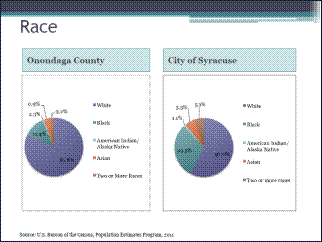 
- Leading predictor – socioeconomic status; present info in context of community
- Syracuse dealing w/population disproportioned by poverty, low education – leading predictors of poor health outcome
 
- #1 in lowest heart disease in state; mortality decreasing at more rapid rate than in other comparable communities
- Part is the health care delivery system (doctors and hospitals); part is social behavioral risk factors of heart disease
 
 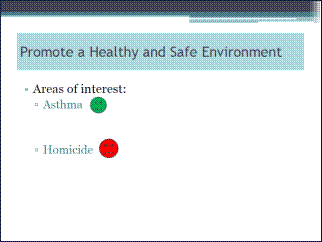
 
Chairman Liedka asked why homicide is lumped with disease since it is inflicted by another human. Dr. Morrow responded:
-
Argue that part of Public Health’s responsibility is to look at all causes of morbidity, sickness and death; view social economics of poverty and gang violence as a public threat
-
Most people would argue it is part of health of community; social disease
-
Job of Public Health System to increase quality of life years of all Onondaga County residents; homicide and who impacts – decreases life expectancy
-
Victims are 20 yrs old or 15 yrs old; decreases life expectancy and impacts more than flu in an 85 year old
-
Vision – community of partners working together for the physical, social and emotional wellbeing of all; Health Department views health as physical, emotional & mental
Chairman Liedka stated during meetings about homicide the focus is usually on the gun side, but the part that is swept to the curb is the mental issues. They are not addressed, and are the bigger problem. Dr. Morrow commented they had a fourth year medical student looking at trauma informed care, which the Health Department is going to get more involved in. For example, a 19 year old is murdered. This does not just affect him, but it impacts the 15 and 17 year old siblings. If a young child is exposed to violence, there is a greater probability that it will change the physiology of the brain. Those children who are victims of violence are not able to achieve good health outcomes. The Health Department has not been as involved as they should be.
Mr. Corl asked what extent they have taken to tackle homicide issues, and is there any collaboration between the Health Department and police agencies; or is it just taking in data. Dr. Morrow responded they are taking in data. They have a physician who works a couple hours a week that Dr. Morrow has asked to address the Health Care Delivery System and violence. Dr. Morrow has had informal discussions with the City and Chief Fowler, but nothing has been set in motion. If someone goes to the emergency room with a stab wound or gun shot, then what is the community doing not only to address the wound, but also to address the needs of everybody who witnessed the event. Southwest Community Center does have a trauma response team, and task force; Dr. Morrow believes they just received a grant. Ideally Dr. Morrow would like to get involved with that, but there are competing needs and resources. There are two areas the Health Department and Health Care Delivery System have agreed to work on. They have agreed to address the top priorities on any given year, and they will be addressing violence in the next year.
Dr. Morrow Continued:
 
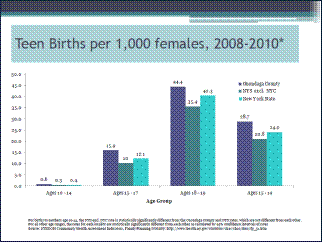 
 
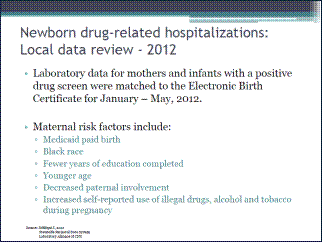 
Chairman Liedka asked if there is data to show what the most popular drug is. Dr. Morrow responded it is in the Community Health Assessment. Cannabinoids (marijuana) and opioids (both prescription and non-prescription narcotics) are equal in this particular study. The other types were equal to each other, but much lower than cannabinoids and opioids.
Dr. Morrow Continued:

- 92% - 94% of the Mom’s and babies with positive drug screens are on Medicaid; direct cost to the tax payer
- 2014 budget request of $50,000 approved in Mental Health’s budget to address this
 
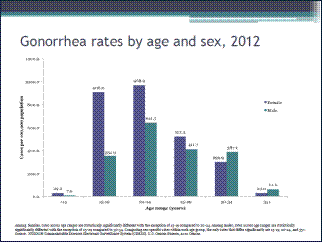 
- Submitted grant to NYS Health Foundation to try to get additional funding to match the Legislature’s funding of $50,000 - bring 5 initiatives together into single collaborative and work on engaging community
- Upstate has pilot project going on; Resident Health Advocate – trying to partner to expand people in community who can act as agents of change
Ms. Chase asked if Dr. Morrow utilizes the school nurses and teachers in reference to STD awareness and pregnancy issues. Dr. Morrow responded they have a Family Life Team, which is made up of nurses who are specifically tasked to work with young adults that are pregnant or parenting. There are nurses assigned to the high schools and middle schools when necessary. Dr. Morrow stated a lot of schools have health based clinics to address STD’s, and the Health Department does partner with them when they can. The Health Department recently did a community forum to address STD’s, and they received money to put up billboards to increase awareness.
Dr. Morrow replied to Ms. Williams that there was a high peak of gonorrhea in 2012, and it was unfortunately maintained in 2013. Ms. Williams asked if this correlated with the bath salt usage. Dr. Morrow responded she does not think so. There is no evidence to confirm, but what they have heard is that there has been a change in culture of older men having sex with multiple young girls. There is no evidence to confirm this. If there is one infected male having sex with 12 or 13 girls, there will be an increase. It would seem that chlamydia would also go up, but it has not.
Mr. Corl asked when they will identify or make conclusions about why the flu has been affecting more middle aged people. Dr. Morrow responded that they know why. The primary circulating strain this year is H1N1, which is the exact same strain as the 2009 pandemic. This disproportionately impacted children, young adults and middle aged people. There are all sorts of theories as to why it disproportionately affects middle aged people. Part of it is that older people have some immunity from H1N1 strains from the past that were similar enough to the current strain to produce some level of immunity. There’s another concept that people who are younger and healthier have a more robust immune response which is a risk factor to H1N1. The biggest thing is that the primary strain of H1N1 is disproportionately affecting the middle aged. Dr. Morrow replied to Mr. Corl that this is automatically included in the flu shot. The global “we” do not know the effectiveness of a particular vaccine until after the flu season is done, but right now it seems to be a very good match. It is not a perfect vaccine, but it is the best they have.
The meeting was adjourned at 10:09 a.m.
Respectfully submitted,

Jamie M. McNamara, Assistant Clerk
Onondaga County Legislature

|


































































